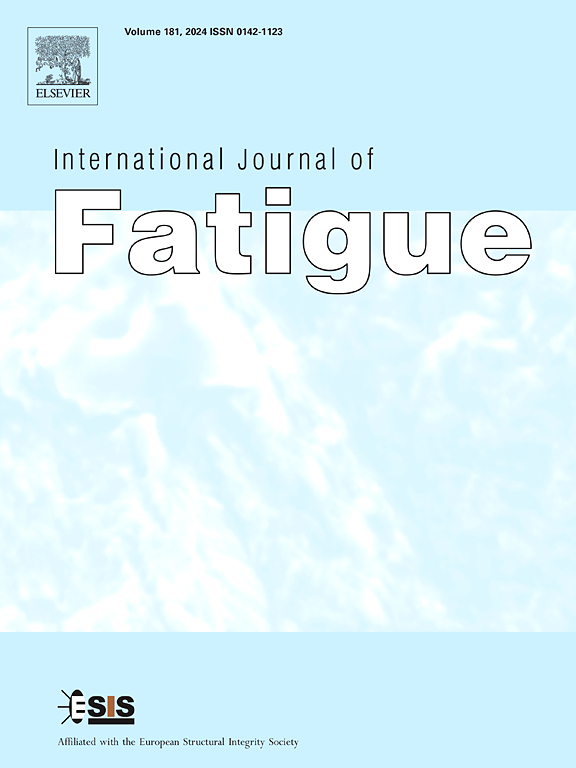随机振动疲劳下碳纤维/环氧复合材料自热行为与损伤机理的关系
IF 6.8
2区 材料科学
Q1 ENGINEERING, MECHANICAL
引用次数: 0
摘要
基于非破坏性热成像的复合材料内部损伤识别和疲劳寿命评估需要研究自热行为与损伤机理之间的关系。本研究开发了一种新的自加热数值算法,该算法将温升贡献分为三个部分:(I)复合材料的粘弹性变形,(II)界面脱粘滑动摩擦和(III)分层摩擦。通过修正粘弹性标准线性实体模型来表征复合材料的粘弹性响应,结合损伤模型来研究层合板在随机振动疲劳过程中的温度演化,并进行了一系列验证实验。在此基础上,深入探讨了复合材料层合板的动力特性、退化模式和损伤阻尼效应。结果表明:温度演化与损伤扩展有显著的关系;粘弹性变形是驱动复合材料自热行为的主要热源,导致感兴趣区域内的热分布均匀。内部损伤改变了对温升的相对贡献,从而改变了复合材料的表面热分布。在整个加载过程中,主要的损伤模式表现出阶段依赖的特征,不同程度地控制着温度的演变。所建立的自热模型为复合材料结构内部损伤的准确识别和高周疲劳寿命的预测提供了新的可能性。本文章由计算机程序翻译,如有差异,请以英文原文为准。

The relationship between the self-heating behavior and damage mechanism of carbon fiber/epoxy composites subjected to random vibration fatigue
Non-destructive thermal imaging-based internal damage identification and fatigue life assessment in composites necessitates investigating the relationship between the self-heating behavior and damage mechanisms. This study develops a novel self-heating numerical algorithm that categorizes temperature rise contributions into three components: (I) the viscoelastic deformation of composites, (II) interface debonding slip friction, and (III) delamination friction. The viscoelastic response of the composite was characterized by modifying the viscoelastic standard linear solid model, coupled with a damage model to investigate the temperature evolution of laminates during random vibration fatigue, and a series of verification experiments were carried out. Furthermore, the dynamic characteristics degradation patterns and damage-damping effect of composite laminates were explored in depth. The results demonstrated that temperature evolution significantly depends on the damage propagation; the viscoelastic deformation serves as the primary heat source driving the self-heating behavior of the composite, resulting in uniform thermal distribution within the region of interest. The internal damage modifies the relative contributions to temperature rise, thereby changing the surface thermal distribution of the composite. Dominant damage modes exhibit stage-dependent characteristics that differentially govern temperature evolution throughout the loading history. The developed self-heating model provides novel possibilities for accurate identification of internal damage and high-cycle fatigue life prediction in composite structures.
求助全文
通过发布文献求助,成功后即可免费获取论文全文。
去求助
来源期刊

International Journal of Fatigue
工程技术-材料科学:综合
CiteScore
10.70
自引率
21.70%
发文量
619
审稿时长
58 days
期刊介绍:
Typical subjects discussed in International Journal of Fatigue address:
Novel fatigue testing and characterization methods (new kinds of fatigue tests, critical evaluation of existing methods, in situ measurement of fatigue degradation, non-contact field measurements)
Multiaxial fatigue and complex loading effects of materials and structures, exploring state-of-the-art concepts in degradation under cyclic loading
Fatigue in the very high cycle regime, including failure mode transitions from surface to subsurface, effects of surface treatment, processing, and loading conditions
Modeling (including degradation processes and related driving forces, multiscale/multi-resolution methods, computational hierarchical and concurrent methods for coupled component and material responses, novel methods for notch root analysis, fracture mechanics, damage mechanics, crack growth kinetics, life prediction and durability, and prediction of stochastic fatigue behavior reflecting microstructure and service conditions)
Models for early stages of fatigue crack formation and growth that explicitly consider microstructure and relevant materials science aspects
Understanding the influence or manufacturing and processing route on fatigue degradation, and embedding this understanding in more predictive schemes for mitigation and design against fatigue
Prognosis and damage state awareness (including sensors, monitoring, methodology, interactive control, accelerated methods, data interpretation)
Applications of technologies associated with fatigue and their implications for structural integrity and reliability. This includes issues related to design, operation and maintenance, i.e., life cycle engineering
Smart materials and structures that can sense and mitigate fatigue degradation
Fatigue of devices and structures at small scales, including effects of process route and surfaces/interfaces.
 求助内容:
求助内容: 应助结果提醒方式:
应助结果提醒方式:


